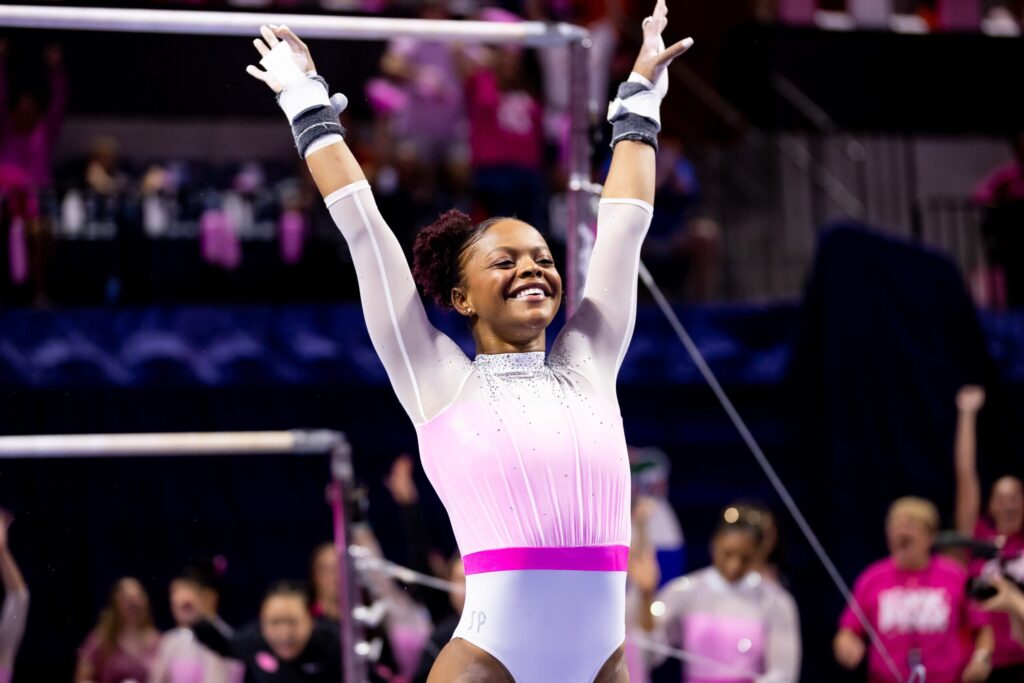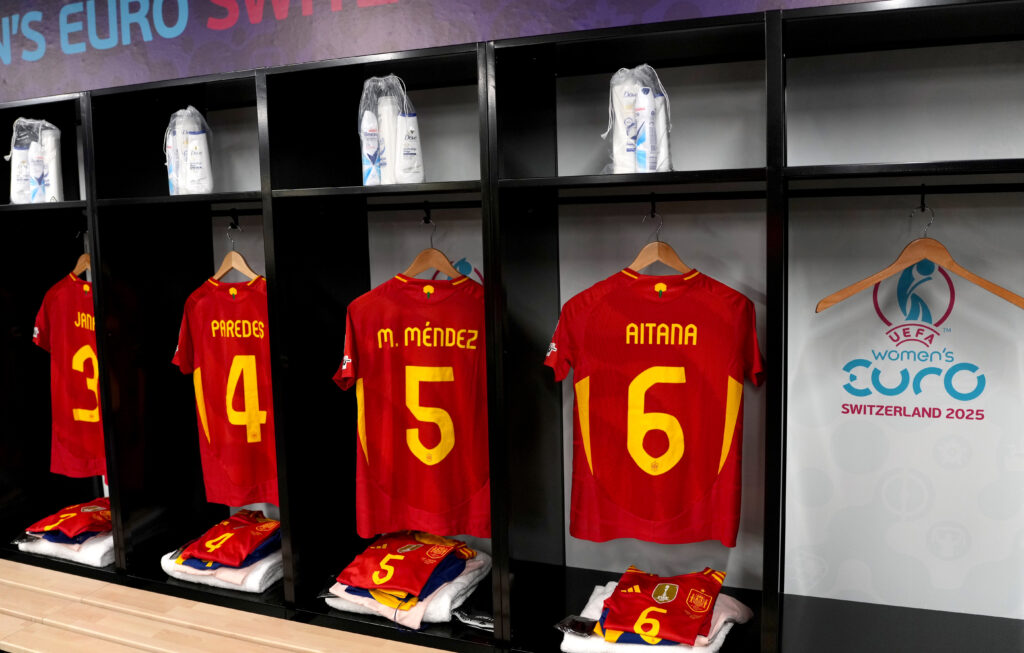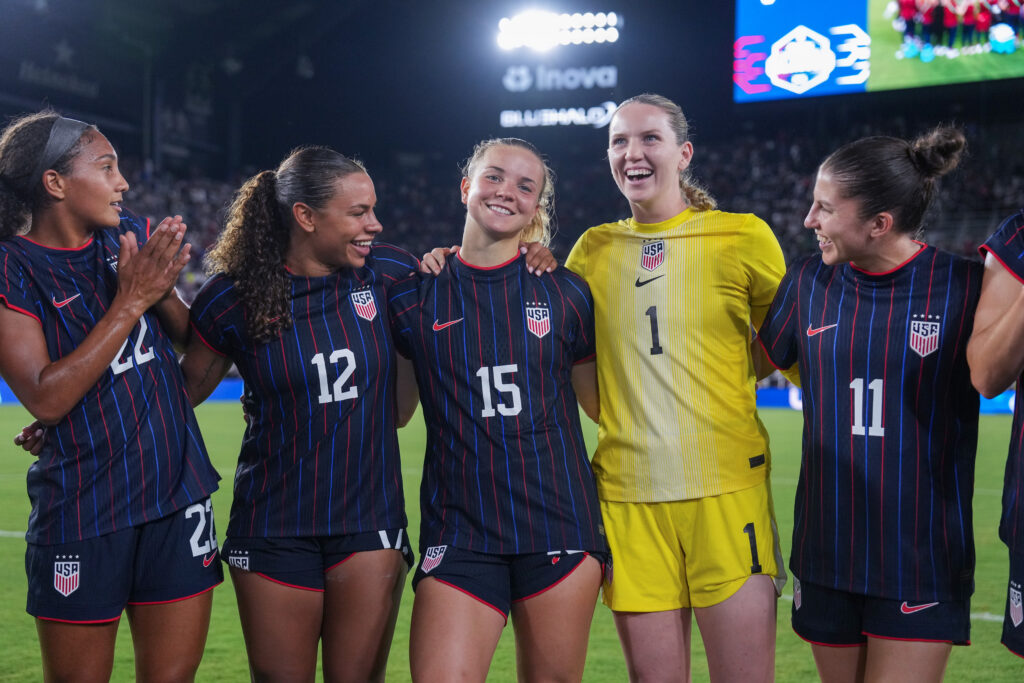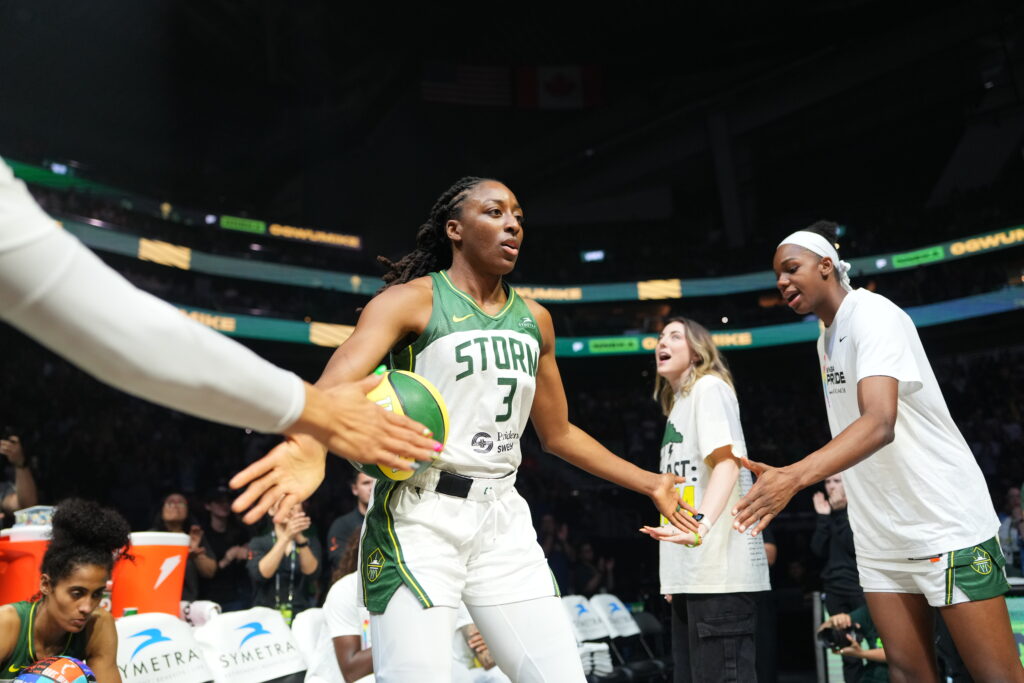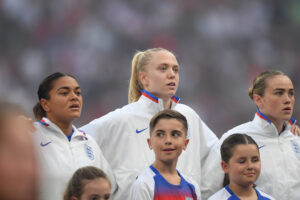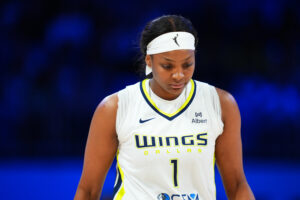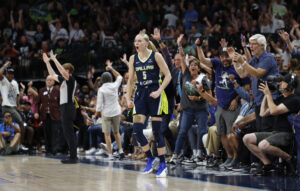It’s a cliché in gymnastics that the best in the sport make it look easy. But you understand why it’s a cliché when you watch Trinity Thomas in action.
Her double layout — two backwards flips in the air with her body held straight — is so light that she appears to be flying. She is perfectly poised on the balance beam in competition, landing difficult tumbling and delicate dance moves with the same surefootedness. On bars, her handstands are the straightest; on vault, she appears to have the reflexes of a cat as she flies up and over the table.
It is no surprise that last January, Thomas completed a Gym Slam — perfect 10s, the highest score in college gymnastics, on each of the four apparatuses. She was only the 12th college gymnast ever to nail a Gym Slam, and only the third from the University of Florida, where she competed this winter season as a “super senior.”
As No. 3 Florida prepares to compete in the NCAA championships, beginning with the semifinals on Thursday, Thomas is just a few days away from completing her fifth and final year in college gymnastics. It’s also possibly her final competitive season of a sport that’s been a part of her identity since she was 7. Thomas is nursing a lower leg injury she suffered at NCAA regionals, and there’s been no official announcement on her status for the championships. But if Thomas can compete at all, she will. The NCAA championship, after all, is the reason the 22-year-old came back to Florida.
Thomas won the NCAA all-around title — that is, the highest score for all four apparatuses combined — at the end of the 2022 season, on top of the NCAA vault and floor titles. She was the only gymnast in the country to win All-America First Team honors on all four apparatuses. She was named SEC Freshman of the Year in 2019, has been a Scholastic All-American during all four of her undergraduate seasons at Florida so far and made the SEC Honor Roll in 2023. Thomas was the SEC Gymnast of the Year during her sophomore season in 2020 and received that honor again in 2022 and 2023, becoming the first Florida gymnast to win it twice and one of only two gymnasts throughout the SEC to win it three times. She was the SEC all-around champion at this year’s conference championship. And she was a finalist for the Honda Award (which she won in 2022) again in 2023.
But the reason Thomas has gained name recognition beyond the gymnastics world this year is the perfect 10 record. Thomas has earned 27 10s in her college career thus far: 12 on floor, six on beam, five on bars and four on vault. Only she and Hope Spivey, a 1988 Olympian who competed for Georgia in the early 1990s, have that many. She is one 10 away from tying Kentucky’s Jenny Hansen and UCLA’s Jamie Dantzcher, who each notched 28 10s for the all-time NCAA record, and she is two perfect routines from claiming that record for herself.
PERFECT 1️⃣0️⃣ FOR TRINITY THOMAS 😤 @GatorsGym @espnW
— ESPN (@espn) January 16, 2022
📺: ABC | #ThatsaW pic.twitter.com/hLzEkJaOFk
So, it was all the more shocking at the regional semifinal in Pittsburgh, where Florida was favored to win and advance to the regional final, to see Thomas stop her floor routine after her first (of three) tumbling passes and mouth to the ESPN camera, “My calf.” She was helped off the floor by a trainer and did not return to competition that night or in the regional final two days later. Florida did advance, but Thomas’ status remains day-to-day for nationals.
It’s also a cliché in gymnastics that the women who do the sport sacrifice everything to make it look that easy, including school, socialization and learning other sports or hobbies. You’ve probably heard an Olympic commentator talk about how a gymnast missed her high school prom in pursuit of medals.
That’s where Thomas will surprise you. Thomas is a graduate student at Florida, where she also received her undergraduate degree in 2022. For her first two seasons at Florida, she maintained her eligibility for the U.S. national gymnastics team, at one point driving from a nighttime college meet straight to a national team camp. In high school, she attended a public school and played varsity sports while training in elite gymnastics for more than 30 hours a week. She went to prom, too, in a Florida-blue gown.
Thomas says that her mom, Tania, told her repeatedly that she should keep her options open as a kid. Not because she didn’t excel at gymnastics (because she always did), but because Tania prioritized fun and exploration over being laser-focused on one sport.
Tania played sports as a child, but they were intertwined with her family and her friendships. Family picnics ended in games; high school track meets ended with friend gatherings outside the stadium. “We always had fun at our sports,” she said.
Tania had never done gymnastics herself, but when Trinity was small, Tania said “she put a hole in my wall.” A neighbor told her to sign Trinity up for gymnastics. She started out in cheerleading and tumbling but was quickly invited to join the gymnastics team at her first gym, Skyline. Tania blanched when she heard about the costs — “$350 just for a warmup,” she recalls, plus another $300 for a competition leotard, and then the fees for the gym and for assessments. “I was like, what did I sign up for?”
When Trinity was little, she would fret about attending birthday parties to which she was invited because she didn’t want to miss gymnastics. “I just wanted to make sure she knew she could miss it,” Tania said.
“I thought that was something that was super important,” Trinity said. “Because sometimes I would make it so serious that it wasn’t fun anymore.”
When Trinity was about 10 years old, she began saying she wanted to quit gymnastics. She told her mother it wasn’t fun. Around the same time, Trinity switched gyms to Artistic Sports Academy in Harrisburg, Pa., where she competed at level 10, the highest level in what was then the Junior Olympic (JO) system and is now known as the USA Gymnastics Developmental Program. The change was a fresh start for Trinity, and she began to enjoy the sport anew.
Unlike many elite gymnasts, Trinity expanded her focus beyond her gym in high school. She dove (and won a state championship title) and ran track at Tania’s urging. “She was one of the first to really pull that off,” Tania said of Trinity’s unusual decision to combine elite gymnastics training with high school sports. Thomas made one final gym change as a young teenager, to Prestige Gymnastics in Lancaster, Pa., where she first qualified for the junior elite level and where she remained for her senior elite career.
In her first year at Florida in 2019, Thomas decided to keep doing elite while also competing in the NCAA. At one point, this meant competing in a college meet, then driving overnight to an elite camp.
Asked whether Trinity has always been a multitasker, Tania thinks for a bit, then says, “Trinity’s a pleaser.” Her daughter can’t say no to things but gets overwhelmed easily, Tania says, and has to work to find a balance between all the things she commits to.
Florida’s head gymnastics coach, Jenny Rowland, said that the instinct to please is not uncommon in their sport, where gymnasts are often reliant on adults to help them learn skills and progress at a young age.
In her first few years at Florida, Rowland would describe Trinity as a “quiet leader” for her squad, but in the last year Trinity’s leadership skills have evolved as her confidence in herself has grown, and she is now more of a vocal leader.
“I didn’t really know that quietness was her lack of self-confidence, for as talented and amazing as she is,” Rowland said.
Rowland said that watching Trinity “take ownership” of her career was very satisfying as a coach. “I just love seeing my student-athletes grow up,” Rowland said.
Trinity Thomas with ANOTHER perfect 10 on the floor 🤩 #ThatsaW | @GatorsGym pic.twitter.com/b5Y11wRkKu
— SportsCenter (@SportsCenter) January 14, 2023
Halley Taylor, who also competed for a fifth season at Florida this year alongside Thomas, has known Thomas since their freshman year. “I think we were both kind of shy,” Taylor said of their first encounters. She now describes Thomas as “goofy” and “silly” and praises her strong leadership skills.
Taylor recalled that Rowland offered her team two different styles of leadership: leading by example or leading by action.
“Trinity does both,” Taylor said. “She’s not the kind of person to tell people what to do, but everyone on the team trusts her.”
Gymnastics was the easy part of Thomas’ decision to take a fifth year.
“My first love is gymnastics, so that part was easy,” she said. “It was just figuring out the real-life things for my last year.” Thomas began classes towards her master’s in health education and behavior over the summer, enrolling in three courses. She says the workload is similar to that of her undergrad, but perhaps with more writing. This fall, she applied to nursing schools. She hopes to begin an accelerated nursing program over the summer in hopes of becoming a nurse practitioner.
Known for her beautiful form, Thomas acknowledges that a focus on the execution of skills versus the skills themselves is the major shift for a college gymnast coming from the elite world, where risky, difficult skills are highly valued in a completely different scoring system. Under the NCAA scoring system, where deductions come out of a perfect 10, it is more important to do easier skills with better form and technique. Once they reach college, most gymnasts know all the skills they will use in competition, and their focus shifts to perfecting those skills instead of learning new tricks.
“You’re looking at every detail, you’re trying to get a perfect 10,” Thomas said. Details, she said, “are something that I personally really focus on.”
That big, beautiful double layout on the floor remains her all-time favorite skill. She likes two transitional skills on the uneven bars, where she floats from the low bar to the high bar: the Maloney, where she catches the bar backwards, and the Van Leeuwen, where she does a half twist before catching. On beam, she loves a front aerial.
Vault remains her least favorite apparatus, but the one she has worked on most to perfect a skill that aids her team. She performs a Yurchenko one-and-a-half vault in competition, where she does a roundoff back handspring onto the vault table, then a laid-out flip with one and a half twists off it. There’s a blind landing involved. But it has a start value of a perfect 10, which is important for teams because not every gymnast can achieve that difficulty.
“That feeling you get when you stick the one and a half is just so cool,” Thomas said.
TRINITY THOMAS 23RD PERFECT 1️⃣0️⃣ @GatorsGym pic.twitter.com/H1j6tteJFd
— SEC Network (@SECNetwork) January 27, 2023
Thomas is not currently competing elite, but she has hinted that Florida’s high-flying former elites in this year’s sophomore class — Olympic alternate Leanne Wong, 2017 World champion Morgan Hurd and World medalist Riley McCusker — had inspired her to keep her options open. “I think just being able to show it’s an option, even if it’s not a popular one, was super important,” she said of her decision to do both when she started at Florida.
The rules have changed since Thomas started college, and elites now can miss camps if they are competing in NCAA. Previously, Thomas had to attend camp in order to keep her spot — and her funding — on the national team. “Some people were like, why would you want to do that?” Thomas said of her insistence on keeping one foot in elite after beginning at Florida. “I got positive stuff back, and negative things.”
Two-thirds of the 2020 United States Olympic team — Sunisa Lee, Jordan Chiles, Grace McCallum and Jade Carey — went to college after the Olympics while keeping their elite options open. That indicated a direct contrast to the previous two Olympic cycles that saw just one gymnast from 2012 and one from 2016 move on to college, both of whom retired from elite gymnastics. “I haven’t made any set-in-stone decisions,” Thomas said of a potential return to elite.
Another rule that has changed during Thomas’ time at Florida is the ability of student-athletes to make money off their name, image, and likeness, also known as NIL. Thomas, not surprisingly given her status as the NCAA’s top female gymnast, was a draw for businesses looking to make connections, though she called the NIL process “a learning curve.” Thomas signed with an agency and began making deals. She is represented by Raymond Representation in Miami, which counts several popular NCAA gymnasts on its roster. “With their help,” Thomas said, NIL has been “way easier to navigate.”
She has signed deals with Honey Stinger, NoCap Sports and, with four of her Gators teammates, College Hunks Moving Company — one of three deals she has inked through the Gator Collective, which helps Florida athletes with their partnerships. This year, Thomas signed a deal with Quatro Apparel to design a leotard line, and others with Amazon, European Wax Center and Tropical Smoothie Cafe, according to On3.com.
“I’ve gotten to work with some really cool companies and make some really cool connections,” Thomas said. “It’s just been cool to learn about a different kind of world, almost an entrepreneurship world.”
Thomas believes that NIL is helping raise the profile of college gymnastics, both for individual athletes and for the sport as a whole. She hopes that young girls watching her compete and appear in ads or as a spokesperson will see her as a role model.
Thomas received the Honda Award, given to the top female athlete in every NCAA sport, in 2022. Then she was a top-three finalist for the Honda Cup, the award for the top female athlete across the NCAA. The cup went to South Carolina basketball star Aliyah Boston, but Thomas had already fulfilled a goal she set as soon as she set foot in Gainesville.
When Thomas arrived on Florida’s campus for the first time to meet with Rowland, the coach asked Thomas her goals for her college gymnastics career. Thomas responded, like most Florida gymnasts she assumes, that she wanted to win an NCAA championship. Then, she added that she wanted to win the Honda Award.
“I want to be up on that wall,” she remembers saying to Rowland, referring to a photo shrine to Florida’s other four Honda Award winners before Thomas: Ann Woods, two-time winners Bridget Sloan and Kytra Hunter, and Alex McMurtry.
The Honda Award meant a lot to Tania Thomas as well. “This is an award women get for their accomplishments,” she said. “It had more meaning to me.” She recounted listening to women at the ceremony tell stories of what it was like to compete before the passage of Title IX in 1972, and how it helped her understand what a big deal it was for Trinity to receive the award.
Now, an NCAA championship is still on the table for her final year as a Gator. Florida placed second at nationals in 2022 and is eager to get over the hump this season. Thomas may be hobbling into the final weekend of the season with a leg injury, but if her career at Florida is any indication, no obstacle will stop her from trying.

Thomas’ 2021 season, her junior year, was looking to be one for the record books. On Feb. 16 of that year, she set a Florida record for the all-around with a 39.90, one-tenth shy of a perfect score and the highest all-around score in the NCAA that year and the fifth-highest in NCAA history. At the same meet, she won at least a share of all five event titles, the first time a Florida gymnast had done so since 2018, before Thomas joined the squad. Thomas won 20 event titles, leading her team. She was the No. 1-ranked all-around gymnast in the country, and most thought she would win the NCAA title that year. As a team, Florida appeared to be in the running for the team title.
And then disaster struck. While warming up for a meet at Alabama on March 5, Thomas dismounted the uneven bars and sprained both ankles. She competed, in pain, at the regional qualifier in Athens, Ga., managing a perfect 10 on bars — the only event in which she competed there — and watching her team advance to nationals. At the same meet, Taylor hurt her calf muscle and Sydney Johnson-Scharpf tore her Achilles tendon. Florida showed up to nationals in tatters.
“That’s probably one of the hardest parts of being a head coach,” Rowland said. “The highs are extremely high, the lows are so low. It’s always really hard to see any injury, especially an injury that just happens at the wrong time.”
Thomas competed in all four events at the national semifinals in 2021 (which also determine individual titles) on sore ankles, eking out a 39.25 all-around score that put her in 11th place in the all-around standings. Florida made it to the four-on-the-floor final but finished fourth and appeared to be hanging on by a thread.
Thomas announced her retirement from elite gymnastics about a month after the 2021 NCAA national championships. She had hoped to compete at Olympic trials and vie for a spot on the U.S. team bound for Tokyo, but her ankles were not healing in time.
“That was definitely a bummer and something I took pretty hard,” Thomas said. “But then I knew that I could come back and I wanted to get my ankles in the best possible shape that I could have them in. I rested my ankles for months.” She remained in physical therapy for her ankles throughout the 2022 NCAA season.
“What was a little bit different about this season for me was pacing myself,” Thomas said. A collaboration between Thomas, her mother, her coaches, her doctor, and her trainer kept her accountable. She focused on rest and recovery and healing her ankles. Her endgame: the postseason.
“I knew it was my senior year,” she said. “I wanted a national championship. That was a huge thing for me.”
Thomas signed on for her fifth year in part to help Florida finally get that national championship during her tenure. Not for her — she feels she has accomplished much of what she hoped to as an individual in the sport. This one’s for her team.
“That’s the one thing I have left to do,” she said. “Every team I’ve been on has worked so hard, and it feels like we’re just climbing this mountain. So I hope that this is the year. I know that we’re capable of it. I know that we’ll work for it.”
Lela Moore is a freelance journalist covering gymnastics. She writes a weekly gymnastics column for The IX Newsletter. Follow her on Twitter @RunLelaRun.
